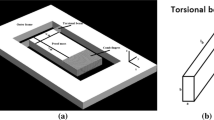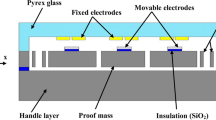Abstract
The performance of micro-machined sensors is primarily determined via the sensitivity of sensing electrode to displacement. This paper presents the design, modelling, optimization and fabrication of an active gap reduction mechanism used on a conventional comb drive to enhance the capacitance in a three axes capacitive micro accelerometer. The design parameters of the active gap reduced comb drive (AGRCD) are optimized for best performance. The finite element analysis of the AGRCD is performed for design verification. The modeling and simulation results demonstrated a 534 % increase in sensitivity of the three axes capacitive micro accelerometer. The three axes capacitive micro accelerometer with AGRCD is fabricated using a commercially available standard metal-multi user MEMS processes.

















Similar content being viewed by others
References
Ayazi F, Najafi K (2000) High aspect-ratio combined poly and single crystal silicon (HARPSS) MEMS technology. J Microelectromech Syst 9:288–294
Bazaz SA, Iqbal A, Khan MS (2013) Monolithic tri-axes nickel based accelerometer design verified through finite element analysis. Arab J Sci Eng 38:2103–2113
Bellot MM (2007) Microelectromechanical sytems (MEMS) safe and arm devices. Master thesis, Air Force Institute of Technology, USA
CoventorWare (2011) Description of CoventorWare, CoventorWare for MEMS CAD Design. http://www.coventor.com/coventorware.html
Cowen A, Dudley B, Hill E, Walters M, Wood R, Johnson S, Wynands H, Hardy B (2000) MetalMUMPs Design Handbook. Revision 2.0, MEMSCap Inc., USA. http://www.memscap.com/mumps/documents/MetalMUMPs.DR.2.0.pdf
Hirano T, Furuhata T, Gabriel KJ, Fujita H (1992) Design fabrication and operation of submicron gap comb-drive microactuators. J Microelectromech Syst 1:52–59
Iqbal A, Bazaz SA (2012) Behavioral modeling of monolithically integrated tri-axis capacitive accelerometer based on MetalMUMPs. Simul J Trans Soc Model Simul Int 88:565–579
Pottenger MD (2001) Design of micromachined inertial sensors. PhD Dissertation, University of California
Pourkamali S, Ayazi F (2003) SOI-based HF and VHF single crystal silicon resonators with sub-100 nanometer vertical capacitive gaps. In: Proceedings of solid-state sensor and actuator workshop, pp 837–840
Riaz K, Bazaz SA, Saleemb MM, Shakoor RI (2011) Design, damping estimation and experimental characterization of decoupled 3-DoF robust MEMS gyroscope. Sens Actuators A 172:523–532
Riaz K, Mian MU, Bazaz SA (2013) Fabrication imperfection analysis of robust decoupled 3-DoF non-resonant MEMS gyroscope. Int J Sci Eng Res 4:686–694
Roylance LM, Angell JB (1979) Batch-fabricated silicon accelerometer. IEEE Trans Electr Devices 26:1911–1917
Seng AB, Dahari Z, Miskam MA, Sidek O (2009) Design and analysis of thermal microactuator. Eur J Sci Res 35:281–292
Toda MR, Takeda N, Murakoshi T, Nakamura S, Esashi M (2002) Electrostatically levitated spherical 3-axis accelerometer. In: Proceedings of 15th IEEE international conference on micro electro mechanical systems (MEMS’02), pp 710–712
Tsai M-H, Sun C-M, Wang C, Lu J, Fang W (2008) A monolithic 3D fully-differential CMOS accelerometer. In: Proceedings of the 3rd IEEE international conference on nano/micro engineered and molecular systems, Sanya, China
Tsuchiya T, Funabashi H (2004) A z-axis differential capacitive SOI accelerometer with vertical comb electrodes. Sens Actuators A 116:378–383
Acknowledgments
This work was supported by the Higher Education Commission (HEC) of Pakistan [Grant No. 1012] and the National ICT Fund of Pakistan [Grant No. ICTRDF/TRED/2008/02].
Author information
Authors and Affiliations
Corresponding author
Additional information
K. Riaz and A. Iqbal participated equally in the paper.
Appendices
Appendix A
1.1 Electrothermal model
It has been found that heat lost through convection and radiation to the ambient can be neglected in comparison with heat dissipated through conduction. This is because the thermal conductivity of Nickel is much larger than ambient air. Therefore, the heat dissipated through convection and radiation to the ambient is neglected for the temperature distribution analysis. Since the length of each arm is much larger than its width and height, a two dimensional model is developed to simplify the analysis as shown in Fig. 18. Using Fig. 18, the steady state heat transfer equations is derived for the arm of the thermal actuator.
According to the principle of heat transfer, heat conduction is given by:
where K p is the thermal conductivity of layer which is Nickel in case of MetalMUMPS, A is the conductive cross sectional area, T is the temperature and x is the length of the structure. If heat is transferred into the structure and then out of the structure, the heat conduction into the structure is given as:
While the heat conduction out of the structure is given by:
where w is the width and h is the height of the thermal actuator. When voltage is applied between the two terminals of this thermal actuator, current is passed through the entire system and travels from one anchor to the other. This results in the joule heat given as:
where J is the current density, ρ is the resistivity of the structure, ρ 0 is the resistivity of the beam at temperature T 0, T 0 is the substrate temperature, ζ is the temperature coefficient of resistance, V is the voltage across the arm and L is the length of the arm.
According to the first law of thermodynamics (conservation of energy), resistive heating is equal to the heat conduction out of the element (Seng et al. 2009), this yield:
Substituting Eqs. 14, 15 and 16 in Eq. 19, taking the limit as dx → 0, produces the following second order differential equation given by Eq. 20:
Since the micro actuator has the same conductive cross sectional area, Eq. 20 is reduced to:
The boundary conditions assumed are that the anchor pads have the same temperature as the substrate, T 0, that is:
Solving Eqs. 21 and 22 gives the temperature distribution along the arm as:
From Eq. 23, it is clear that the temperature is parabolic and symmetric about the centre point of the length with a maximum temperature, Tm, at x = L/2. By substituting x = L/2, the maximum temperature is:
The maximum temperature varies proportionally to the square of the applied voltage and inversely proportional to the density and thermal conductivity.
Appendix B
2.1 Mechanical model
In this section, deflection of a simplified model of a u-shape thermal actuator is examined. Figure 18 shows the model of the single beam structure. When the thermal gradient perpendicular to the beam axis is imposed, the heat transfer by conduction in a plane beam is given as (Seng et al. 2009):
By imposing the temperature profile, we get
where T c is the temperature of the bottom of the beam (cold arm temperature) and T h is the temperature of the top of the beam (hot arm temperature). Equation 25 shows that the top of the beam mimics the hot arm of the microactuator while the bottom of the beam mimics the cold arm of the microactuator.
By denoting the deflection in the x–y plane by v(x), the steady state deflection of an elastic beam is (Seng et al. 2009):
where E is the Young’s modulus of the beam, I is the moment of inertia, v is the deflection of the beam, P is the load of the beam and F is the applied force. If we assume there is no motion of the beam in the y–z plane then the applied force can be written as:
Assuming that the load P (x) i.e. the contribution from the effects other than thermal stress is identically zero. The term M Tz is computed by:
where M Tz is the bending moment and α is the thermal expansion coefficient. From Eq. 29, the integral is an area integral over the cross section of the beam. Using the assumption regarding the temperature and assuming that α and E are constant, expression becomes:
The assumption that there is no motion in the y–z plane is required to assume the analogous quantity M Ty defined as:
This equation is defined to be identically zero. This follows from the assumed temperature field. The expression for M Tz implies that:
Substituting Eq. 31 into Eq. 27 gives F = 0. Therefore, both equations reduced to:
Let us further assume that P = 0 and hence simplify to:
Assuming the left end of the beam is held fixed or anchored, the boundary conditions can be applied:
Assume the right end of the beam is free or unsupported. In the presence of thermal stresses, the boundary conditions at the free end of a beam are (Seng et al. 2009):
Using Eq. 30, this can be reduced to:
The differentiation of above equation gives:
Taking the integration of the equation below and applying the boundary condition yields the beam deflection:
Finally, the deflection in Eq. 40 is obtained as:
where I is defined as:
Finally, the deflection in Eq. 40 is obtained as:
where L ch is the length of the cold hot arm linkage, L h is the length of hot arm, L c is the length of cold arm, W h is the width of hot arm, W c is the width of cold arm, W f is the width of flexure, L g is the distance between hot and cold arm, and L f is the length of flexure.
Appendix C
3.1 Force model
For a single beam, when the temperature is different from the ambient temperature, it undergoes either expansion or compression. The change of the beam length can be calculated using:
where α(T) is the thermal expansion coefficient. If we assume α(T) is constant for various temperatures, the equation of thermal expansion can be simplified to:
Putting T(x) from Eq. 23 into above equation and solving it yields:
Once the temperature distribution for each beam is known, ΔL and an equivalent force generated due to thermal expansion can be found using the following Eq. 49:
Rights and permissions
About this article
Cite this article
Riaz, K., Iqbal, A., Mian, M.U. et al. Active gap reduction in comb drive of three axes capacitive micro accelerometer for enhancing sense capacitance and sensitivity. Microsyst Technol 21, 1301–1312 (2015). https://doi.org/10.1007/s00542-014-2377-3
Received:
Accepted:
Published:
Issue Date:
DOI: https://doi.org/10.1007/s00542-014-2377-3





